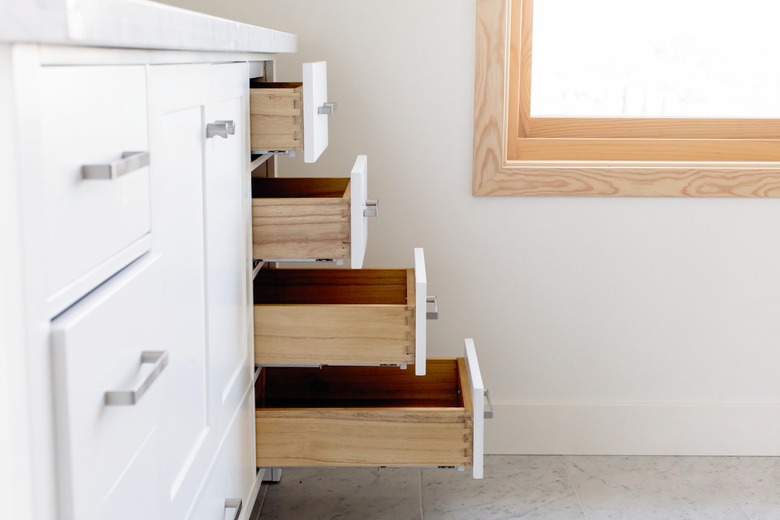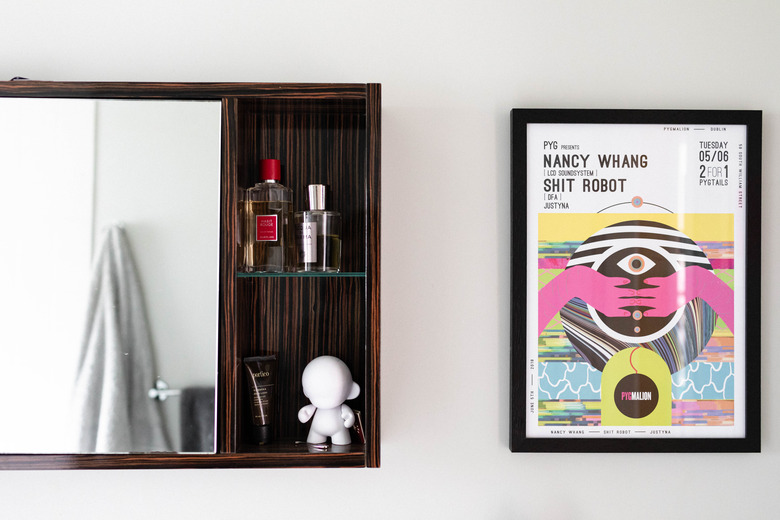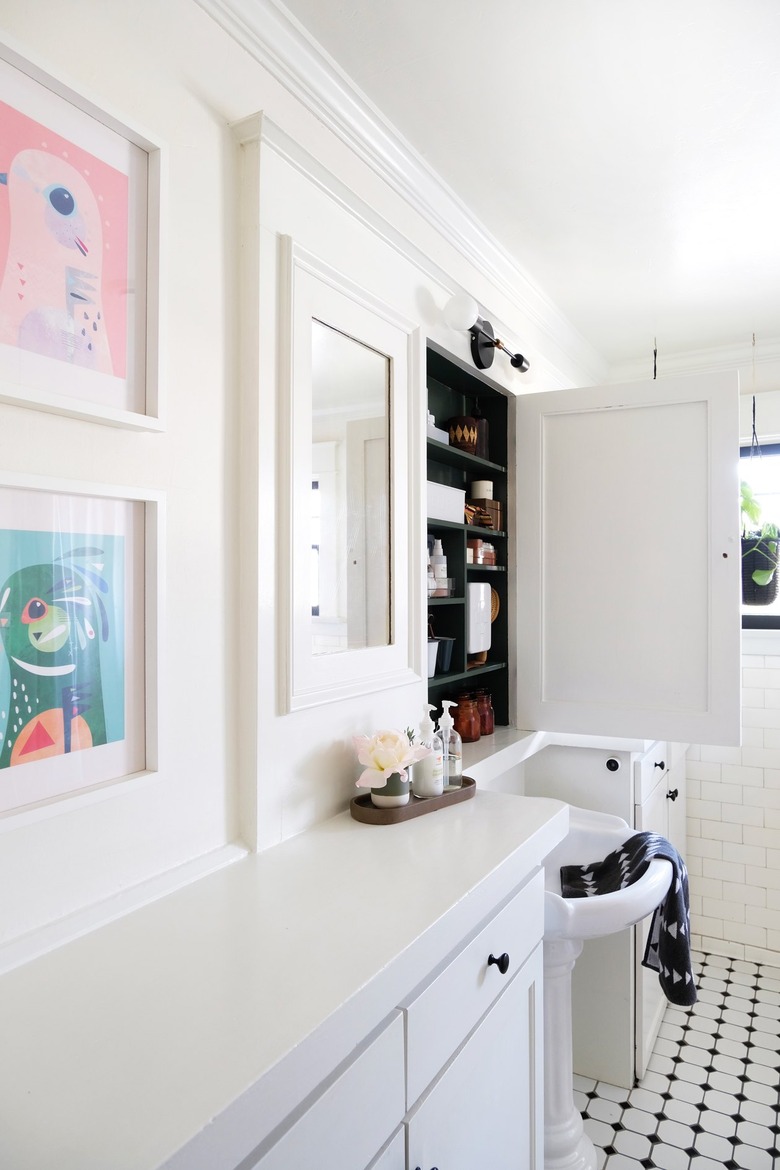Wall-Mounted Bathroom Cabinets: A DIY Homeowner's Guide
A wall-mounted bathroom cabinet can offer an excellent opportunity to increase your storage space in a way that is both eye-catching and an effective use of your space. While there are many types of commercially available wall-mount bathroom cabinets available, you can also repurpose other wall-mount cabinets or even make your own. Whatever kind of cabinet you plan to install, wall mounting is usually a fairly straightforward home improvement project.
Wall-Mounted Bathroom Cabinet Varieties
Before shopping for a wall-mounted bathroom cabinet, it's important to research the right type of cabinet for your needs. While most people are familiar with vanity cabinets and medicine cabinets, there are other cabinet options available as well. Consider these four cabinet types:
- Vanity cabinets:
This storage cabinet fits under the vanity top and sink where most people
store their toiletries, cleaning supplies and bathroom accessories. Vanity cabinets come in a wide array of
sizes, with the most common being between 24 and 72 inches, although it is
possible to find designs outside of this range as well. Shorter models may have only one door, while longer designs often have two doors and multiple sets of
drawers and/or cubbies. Two benefits of installing a wall-mounted vanity
cabinet are that you can choose exactly the height you want your sink to be and they
provide good under-cabinet space to store items like your bathroom scale,
children's step stools and slippers. - Medicine cabinets:
These are fitted on or into the wall, to the side of the bathroom sink or directly above the
bathroom sink. These are largely used to store medicine, as the name implies,
and toiletries. While most medicine cabinets are fitted with at least one adjustable
shelf and a mirrored door, some have shelves that are fixed in place, drawers or
glass or solid-wood doors. Kohler
notes that medicine cabinets installed above a vanity should be the same width as the vanity or narrower than the vanity, and while 15- and 20-inch cabinets are the most
popular sizes, they are commonly sold in sizes of up to 40 inches. - Linen cabinets: These
are a great storage solution for both clean towels and extra bath mats. Linen
cabinets come in single-door, double-door and open-shelf designs and are a wide
variety of sizes and shapes, ranging from long and tall to short and wide. No
matter the shape and size, these should ideally be at least 18 inches in every dimension
to properly fit folded towels and bath mats. - Multifunction storage cabinets: Whereas linen cabinets tend to have only shelves to store
towels and bath mats, some bathroom cabinet storage options are more versatile
and may have towel racks, drawers, open shelves or adjustable shelves. These can
come in any size or shape and can be fitted on the wall above the door, over the
toilet, beside the shower, between the bathroom mirrors of a double vanity or
anywhere else you may need a little more storage space.
Common Bathroom Cabinet Materials
A wall-mounted bathroom cabinet can be made from almost any of the same materials as a free-standing bathroom cabinet. Home Stratosphere says some of the most common bathroom wall cabinet materials include:
- Solid wood: Wood
is one of the most popular cabinet materials because it has a classic beauty, can
be stained any shade and when scratched, it can be easily repaired. However, because
most woods do not hold up well to humidity, these aren't optimal for a
busy bathroom. Instead, a wood bath cabinet might be best reserved for a powder
room or guest bathroom. - Laminate: Cabinet laminate is a thinner version of the familiar countertop material. It's made with plastic laminate (layers of paper and resin) glued to engineered wood such as
medium-density fiberboard (MDF), particleboard or plywood. Laminate is easy to clean and comes in a wide array of styles,
textures and colors. While the laminate layer is resistant to nicks and stains, if it gets damaged, it cannot be repaired. Also, over time, it can become loose and
unglued. - Thermofoil: Similar
to laminate, thermofoil is made from layers of plastic or vinyl vacuum-pressed
to fiberboard. Thermofoil can look nearly identical to solid wood but is far
more affordable and does better in humidity. Unfortunately, it can be easily dinged,
chipped and scratched, and this damage cannot be repaired. - Bamboo: Bamboo
boards, made from pieces of bamboo that are compressed together, are eco-friendly
because it is an easily renewable resource. They are easy to clean, have a
unique texture and can even be made to look similar to wood. On the downside,
like solid wood, bamboo doesn't always do great with humidity, and it is
particularly expensive. - Stainless steel:
Generally only used for medicine cabinets, stainless steel cabinets can be trimmed
with chrome or fitted with a mirror-covered door. When used for other cabinets,
stainless steel can be left exposed to complement an industrial-looking home
decor theme.
Where to Buy Wall-Mounted Bathroom Cabinets
It's easy to find a new wall-mounted bathroom cabinet. They can be purchased at home improvement stores, furniture stores, designer websites and more. If you're looking to buy used furniture, you can, of course, look for wall-mounted bathroom cabinets, but you don't have to limit yourself to bathroom furniture.
You can also repurpose wall-mounted TV cabinets, kitchen cabinets, storage units, etc. as long as the materials are acceptable for bathroom use, meaning you should avoid anything that can rust or become cracked or warped in a high-humidity environment. You can find used bathroom furniture and items to repurpose at resale shops and estate sales, or you can even reuse items that have outgrown their usefulness in your own kitchen or living room.
If you have a very specific idea in mind, you can also have cabinets custom built by a cabinetmaker or look up directions online for DIYing your own wall-mounted bathroom cabinet.
Installing a Wall-Mounted Bathroom Cabinet
Warning
If you're planning to install a heavy bathroom cabinet, it may be best to hire a professional, as a support brace to the studs might be needed to properly secure it to the wall.
If you buy a new wall-mount cabinet, it should come with installation instructions. Always follow those directions, as they may include details specific to the style, material or finish of the cabinet. If you're installing a bathroom vanity or other heavy wall cabinet, you'll need to hire a professional or look up specific instructions for this type of installation, as you may need to add a support brace to the studs behind the drywall.
For all other cabinets, start by having a helper (or two) lift the cabinet to the desired location. If you're centering it on a wall or above another piece of furniture, use a tape measure to ensure it is centered. Use a level to ensure the cabinet is level and then mark the center of the sides where the cabinet should sit.
Use a stud finder to locate the studs in the installation area and then mark these with a pencil. Measure the location of the studs compared to the cabinet's edges and write down this information. Transfer the stud locations to the back of the cabinet; most cabinets have a mounting rail of solid wood at the top (and sometimes along the bottom) to provide solid backing for screws. Drill pilot holes at the marked locations.
Have your helper(s) hold the cabinet in place. Confirm that the cabinet is level and then drive 2- or 3-inch screws through the pilot holes and into the wall studs. Finally, fill over the screw heads with wood putty and paint (as needed) to hide the screws.


